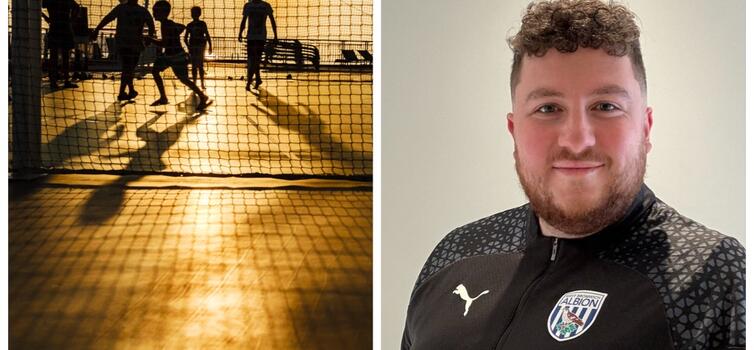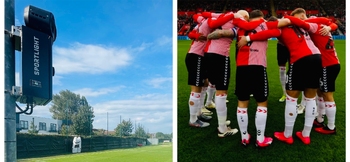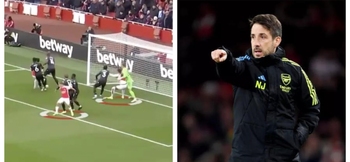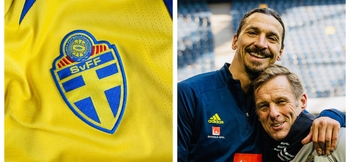Kieran Squire: Benefits of cage football in youth development

Kieran Squire: Foundation Phase Lead at West Brom and a big believer in cage football and similar formats
Written by Kieran Squire — January 16, 2024
SEVEN of the 25 players selected for the most recent England squad (November 9th 2023) grew up in London and regularly played cage football when they were youngsters.
Marc Guehi, Fikayo Tomori, Ezri Konsa, Declan Rice, Conor Gallagher, Bukayo Saka and Levi Colwill have all spoken about the importance of informal restricted-space formats in their formative football years.
Examples of such formats are cage football, panna, MUGA (multi-use games area) and street football, where the ball is always in play and the surface allows it to be moved quickly. These are distinct from futsal, where there are lots of restarts and more rules.
Liverpool Assistant Pep Lijnders recently told TGG the club had built a gaiola (Portuguese word for cage) at their AXA Training Centre to recreate the spirit of the streets.
Reflecting on my own experiences in football - as a player, coach and now Foundation Phase Lead at West Brom - I have seen many benefits of youngsters in particular taking part in restricted-space football, which I will outline in this article.
These benefits help players as they move to more traditional formats of the game like 7v7, 9v9 and 11v11.
1. Repetition and Exposure to Attacking 1v1s
The intensity and aggressive nature of cage football, panna, MUGA and street football means there is constant pressure on players. They are frequently forced into wide areas away from goal, meaning pressure from the 5ft boards or fencing around the outside of the pitch.
If they don’t show sufficient awareness, they will often be forced into those boards, which means they have to use speed or counter aggression with body movements to retain the ball.
If they turn to play back, the pressure will often still stay high, because most teams (either intentionally or unintentionally) play ‘man to man’. This means players have to show creativity to play out.
Other examples of the creativity we see in these formats:
- Playing the boards to pass to a team-mate.
- Turning into pressure to take the boards away from the 1v1.
- Using speed to get away and either progress up the pitch or win a foul.
- Facing the boards and using the wall to create a barrier between the defender, attacker and ball, and using ‘pin and roll’ techniques to escape pressure.
2. Repetition of defending 1v1s

Our Youth Development 2023 Webinar features nine presentations, including:
- Des Ryan: Physically developing the player & person
- Mathieu Lacome: Using data to aid player development at Parma
- Jack Brazil: Foundation to first team at PSV Eindhoven
- Hannah Dingley: Another way at Forest Green Rovers
- Tom Hocking: Video analysis at Wolves Academy
To find out more and to buy the webinar, click the button below.
As I’ve already said, most teams go ‘man to man’ in these formats. When playing five-a-side in cage football, for example, it’s difficult to create overloads, meaning it becomes easier to apply pressure to try and turn over possession.
A player will often force his or her opponent outside towards the boards, because this reduces space and increases the likelihood of either winning the ball back or forcing them backwards.
In these 1v1 situations, pressure is aggressive and intense. With limited chances of being beaten on the outside - because you will run out of space - pressure can be applied quickly. When players try to ‘pin’ defenders using the boards, there will often be an ice-hockey style body check into them.
This can result in fouls been given away if the aggression isn’t applied in a controlled way. This means players learn to apply pressure in a controlled way and to show players outside and away from goal. This links to principles of play in the traditional formats of the game, where forcing away from pressure and protecting the middle of the pitch are fundamentals when out of possession.
Furthermore, players often need to rotate positionally to defend their goal or apply pressure in different areas of the pitch. This enables them to experience defending in a greater variety of spaces than they might in other formats.
3. Forced creativity in tight areas under pressure
When receiving the ball, it’s important that space is created early, which means players are forced to be creative. They learn to do this through their receiving skills, deception and timing of touch to move the ball away from pressure.
In big spaces, players develop the ability to chop or use outside touch to get away from pressure to make space. If pressure is high, players are forced into small fast movements and feints to create a stand-off, where attackers are trying to penetrate and progress the ball.
Panna football is great for developing these small fast movements. Panna (the Dutch word for nutmeg) means rolling the ball between an opponent's legs. The aim of the game is to beat your opponent by scoring more goals or playing the ball through the legs.
I’ve tried this format with young Academy footballers and would say it's cage football in microcosm. The player with the ball encourages the opponent to commit pressure so they can then perform the panna.
This is really useful when taken into cage football and through to traditional formats. Players encourage their opponent to commit, then attempt to beat them and move into space.
4. Finishing low and hard
Most goals in these formats are 16’x4’, meaning they are low and wide. To score from distance, you generally need to aim for the corners and shoot low and hard.
When players receive the ball inside the scoring area, they often use feints and deception to create space around the goalkeeper so they can pass the ball into the goal.
This is again very useful in traditional formats, where players need to finish in limited space when 1v1 against the keeper. Additionally, players learn how to finish around a defender.
They use the defender as a blocker against the keeper and recognise when they can slide finishes around defenders and into the goal. This links into finishing around chaos in the box in the traditional format.
In formats like MUGA, the goal tends to be the traditional box shape and goals can be scored in similar ways to 7v7 games. Players can use a wider variety of finishes and take more risks by shooting from further out.
In my experience, both goal sizes have benefits: box goals provide more realism; short wide goals encourage players to use skills such as technique, timing and deception.
5. Physical and psychological development
Cage football and the like are fast-paced, intense and aggressive. Due to the high repetition of 1v1 duels, players are often in individual battles in which they are tussling for space and contact to win or keep possession.
Players increase the number of times they need to apply take-on and escaping skills, using feints and double movements to create room in limited space.
In turn, this means players are using more agility skills such as twisting, turning, accelerating and decelerating. Much of the time they will be performing these actions when fatigued, because the ball never goes out of play.
Organised games of these restricted-space formats are often 10 to 15 minutes, although the Football Association rules stipulate periods of anything between five and 25 minutes.
In non-organised games, players will play until they are tired or need to go home, which allows for variation in intensity. As players get older, they need natural breaks and will learn to find the best balance between volume, technique and intensity.
In Academies, terminology such as red and green zone are used to help youngsters understand their different states of mind and how best to deal with them. When players are stressed physically, their psychological stress will often be amplified.
From what we have observed in cage football, there are lots of opportunities for players to experience frustration. The high-scoring nature of the games mean they experience many emotional highs and lows.
This, in turn, provides opportunities for them to develop psychologically to deal with the challenges they will face in traditional formats.
6. Ball rolling quickly
Ball-rolling speed is important in developing the ability to stay on the ball and combine with team-mates. Their receiving skills are also very important in maintaining possession.
Showing deception in receiving the ball and keeping it ‘safe side’ and away from defenders are key. Players use the soles of their feet much less in cage football than in futsal, meaning receiving skills are closer to what you might typically see in traditional formats.
However, the ball often arrives much quicker in these formats than on grass, because of the hard surfaces or short flat AstroTurf in the cages.
In some mugas the floor is tarmac, meaning the ball rolls even quicker and requires techniques and skills that are similar to futsal. Firm and accurate passes are rewarded, although inaccurate passes will sometimes go unpunished because the ball stays in play and could still find a teammate.
Long passes into the corners can be dangerous, because they put the opposition under pressure in confined spaces close to goal. You can further constrain the practice by adding a futsal ball, which changes the dynamic and encourages players to play short to combine more often instead.
In that scenario, playing longer can become more challenging. Adding constraints into games can help improve quality and passing skills. This may also encourage players to maintain possession more effectively.
7. Accessibility
Generally, players are able to turn up to cages or mugas at any time of the day and play for free. More organised cage games also take place regularly and are usually much cheaper than hiring a quarter, half or full-size AstroTurf pitch.
Contact time is greater than more organised team training that may only occur once a week for grassroots players. Professional Academies are now increasingly using these facilities and formats.
The Premier League now hosts regular 5s festivals, in which Academies compete in a tournament throughout the day gainst a wide variety of opposition from across the country.













